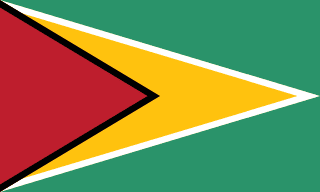Guyana - Geography

Here, let us take a look at the Geography of Guyana. The third-smallest country in South America after Suriname and Uruguay; contains some of the largest unspoiled rainforests on the continent. Mother's mean age at first birth is 20.8 years (2009 est.) (Note: data represents median age at first birth among women 25-29), whereas, the Maternal mortality ratio is 75 deaths/100,000 live births (2023 est.)
Geographical data of Guyana
| Location | Northern South America, bordering the North Atlantic Ocean, between Suriname and Venezuela |
|---|---|
| Geographic coordinates | 5 00 N, 59 00 W |
| Map references | South America |
| Tarrain | mostly rolling highlands; low coastal plain; savanna in south |
| Natural Resources | bauxite, gold, diamonds, hardwood timber, shrimp, fish |
| Natural Hazards | flash flood threat during rainy seasons |
| Irrigated Land | 1,430 sq km (2012) |
| Major rivers (by length in km) | |
| Major aquifers | |
| Land Boundaries | 2,933 km |
| Border Countries | Brazil 1,308 km; Suriname 836 km; Venezuela 789 km |
| Coastline | 459 km |
| Climate | tropical; hot, humid, moderated by northeast trade winds; two rainy seasons (May to August, November to January) |
| Area | |
| Total Area | |
| Land Area | 196,849 sq km |
| Water Area | 18,120 sq km |
| comparative Area | slightly smaller than Idaho; almost twice the size of Tennessee |
| Maritime Claims | |
| Territorial sea | 12 nm |
| Exclusive economic zone | 200 nm |
| Continental shelf | 200 nm or to the outer edge of the continental margin |
| Elevations | |
| Highest point | Laberintos del Norte on Mount Roraima 2,775 m |
| Lowest point | Atlantic Ocean 0 m |
| Mean elevation | 207 m |
| Land Use | |
| Agricultural land | 3.4% (2023 est.) |
| Agricultural land: arable land | arable land: 0.5% (2023 est.) |
| Agricultural land: permanent crops | permanent crops: 0.1% (2023 est.) |
| Agricultural land: permanent pasture | permanent pasture: 2.8% (2023 est.) |
| Forest | 87.1% (2023 est.) |
| Other | 9.5% (2023 est.) |
Population Distribution
Population is heavily concentrated in the northeast in and around Georgetown, with notable concentrations along the Berbice River to the east; the remainder of the country is sparsely populated
People and Society
In Guyana, the different Ethnic groups are such that we have: East Indian 39.8%, African descent 29.3%, mixed 19.9%, Indigenous 10.5%, other 0.5% (includes Portuguese, Chinese, White) (2012 est.)
| Population | |
|---|---|
| Pop growth rate | 0.32% (2024 est.) |
| Birth rate | 16.7 births/1,000 population (2024 est.) |
| Death rate | 7 deaths/1,000 population (2024 est.) |
| Health expenditure | |
| Physicians Density | |
| Hospital bed Density | 2.6 beds/1,000 population (2021 est.) |
| Total fertility rate | 2.05 children born/woman (2024 est.) |
| Gross reproduction rate | 1 (2024 est.) |
| Contraceptive prevalence rate | |
| Est married women (ages 15-49) | 62.6% (2023 est.) |
| Literacy | |
| Education expenditures | |
| Net Migration rate | -6.6 migrant(s)/1,000 population (2024 est.) |
| Nationality | Guyanese | Guyanese (singular and plural) |
| Languages | English (official), Guyanese Creole, Amerindian languages (including Caribbean and Arawak languages), Indian languages (including Caribbean Hindustani, a dialect of Hindi), Chinese (2014 est.) |
| Religions | Protestant 34.8% (Pentecostal 22.8%, Seventh Day Adventist 5.4%, Anglican 5.2%, Methodist 1.4%), Hindu 24.8%, other Christian 20.8%, Roman Catholic 7.1%, Muslim 6.8%, Jehovah's Witness 1.3%, Rastafarian 0.5%, other 0.9%, none 3.1% (2012 est.) |
| Age Structure | |
| 0-14 years | 23.5% (male 95,223/female 91,272) |
| 15-64 years | 68.4% (male 281,669/female 261,261) |
| 65 years and over | 8.1% (2024 est.) (male 28,352/female 36,322) |
| Dependency Ratios | |
| Total dependency ratio | 46.3 (2024 est.) |
| Youth dependency ratio | 34.3 (2024 est.) |
| Elderly dependency ratio | 11.9 (2024 est.) |
| Potential support ratio | 8.4 (2024 est.) |
| Median Age | |
| Total | 28.3 years (2024 est.) |
| Male | 28.2 years |
| Female | 28.4 years |
| Urbanization | |
| Urban population | 27.2% of total population (2023) |
| Rate of urbanization | 1.01% annual rate of change (2020-25 est.) |
| Major urban areas (Pop) | 110,000 GEORGETOWN (capital) (2018). |
| Sex Ratio | |
| At birth | 1.05 male(s)/female |
| 0-14 years | 1.04 male(s)/female |
| 15-64 years | 1.08 male(s)/female |
| 65 years and over | 0.78 male(s)/female |
| Total population | 1.04 male(s)/female (2024 est.) |
| Infant Motality | |
| Total | 21.1 deaths/1,000 live births (2024 est.) |
| Male | 23.9 deaths/1,000 live births |
| Female | 18.3 deaths/1,000 live births |
| Life Expectancy at birth | |
| Total population | 72.4 years (2024 est.) |
| Male | 70.6 years |
| Female | 74.3 years |
| Drinking Water Sources | |
| Improved: urban | urban: 96% of population (2022 est.) |
| Improved: rural | rural: 95.8% of population (2022 est.) |
| Improved: total | total: 95.9% of population (2022 est.) |
| Unimproved: urban | urban: 4% of population (2022 est.) |
| Unimproved: rural | rural: 4.2% of population (2022 est.) |
| Unimproved: total | total: 4.1% of population (2022 est.) |
| Sanitation facility acess | |
| Improved: urban | urban: 98.7% of population (2022 est.) |
| Improved: rural | rural: 99.5% of population (2022 est.) |
| Improved: total | total: 99.3% of population (2022 est.) |
| Unimproved: urban | urban: 1.3% of population (2022 est.) |
| Unimproved: rural | rural: 0.5% of population (2022 est.) |
| Unimproved: total | total: 0.7% of population (2022 est.) |
| Alcohol consumption per capita | |
| Total | 5.11 liters of pure alcohol (2019 est.) |
| Beer | 2.75 liters of pure alcohol (2019 est.) |
| Wine | 0.04 liters of pure alcohol (2019 est.) |
| Spirits | 2.3 liters of pure alcohol (2019 est.) |
| Other alcohols | 0.02 liters of pure alcohol (2019 est.) |
| Tobacco use | |
| Total | 9.2% (2025 est.) |
| Male | 16.9% (2025 est.) |
| Female | 1.9% (2025 est.) |
| Child marriage | |
| Women married by age 15 | 6.3% (2020) |
| Women married by age 18 | 32.3% (2020) |
| Men married by age 18 | 11.9% (2020) |
Demographic profile
All Important Facts about Guyana
Want to know more about Guyana? Check all different factbooks for Guyana below.









